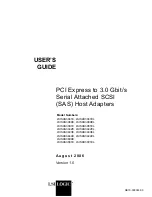
Linux Driver Support
Then, instruct the system to load the module when booting. Use the following
commands:
#echo “modprobe rr2310_00” > /etc/init.d/hptdriver
#chmod 755 /etc/init.d/hptdriver
#ln –sf /etc/init.d/hptdriver /etc/rc.d/rc3.d/S01hptdriver
#ln –sf /etc/init.d/hptdriver /etc/rc.d/rc4.d/S01hptdriver
#ln –sf /etc/init.d/hptdriver /etc/rc.d/rc5.d/S01hptdriver
Step 4 Configure System to Mount Volumes during Startup
The system can be instructed to automatically mount the array(s) during startup by
modifying the file”/etc/fstab”.
For example, add the following line to tell the system to mount /dev/sda1 to location /
mnt/raid after startup:
/dev/sda1 /mnt/raid ext2 defaults 0 0
4 - Updating the Driver
If you are not booting from disks attached to RocketRAID host adapter, you can
update the driver just by reinstalling it following the procedure outlined in the
previous section, “Installing the RocketRAID driver for an Existing System”.
If you are running the system installed to a disk or array attached to the RocketRAID
host adapter:
First, obtain the new driver module “rr2310_00.ko”. Refer to the previous section
“Obtain the Driver Module”. In following steps, we assume it has been
copied to “/tmp/rr2310_00.ko”.
Replace rr2310_00.ko in the boot RAM disk image, /boot/initrd-xxx.img (where xxx
is the kernel version).
5-8
















































